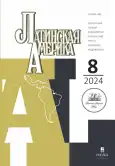Taming inflation: the Brazilian experience of combatting inflation in the last quarter of the 20th century
- Authors: Lisovolik Y.D.1,2, Kazelko A.A.3
-
Affiliations:
- Russian International Affairs Council (RIAC)
- BRICS+ Analytic
- TV BRICS
- Issue: No 8 (2024)
- Pages: 39-53
- Section: Economy
- URL: https://journals.rcsi.science/0044-748X/article/view/261699
- DOI: https://doi.org/10.31857/S0044748X24080025
- ID: 261699
Cite item
Full Text
Abstract
About the authors
Yaroslav D. Lisovolik
Russian International Affairs Council (RIAC); BRICS+ Analytic
Email: yl@brics-plus-analytics.org
ORCID iD: 0009-0004-0522-529X
Director Moscow, Russia
Alisa A. Kazelko
TV BRICS
Email: alisakazelko@mail.ru
ORCID iD: 0000-0002-8184-1041
expert Moscow, Russia
References
- The World Economic Situation and Prospects as of mid-2023. The Global Economic Monitoring Branch in the Economic Analysis and Policy Division of the United Nations Department of Economic and Social Affairs, 2023. Available at: https://www.un.org/development/desa/dpad/publication/world-economic-situation-and-prospects-as-of-mid-2023. (accessed: 10.07.2023).
- Bresser Pereira L. C., Nakano Y. Hiperinflação e estabilização no Brasil: o Primeiro Plano Collor. São Paulo, Revista de Economia Política, 1991, vol. 11, N 4, p. 89-114. doi: 10.1590/0101-31571991-0895
- Brasil, Ministério da Fazenda. Banco Central do Brasil (BCB). Sistema de Metas Para Inflação. Available at: https://www.bcb.gov.br/controleinflacao/metainflacao (accessed: 10.08.2023).
- GDP growth (annual %), Brazil. The World Bank. Available at: https://data.worldbank.org/indicator/NY.GDP.MKTP.KD.ZG?locations=BR/ (accessed: 22.07.2023).
- Окунева Л.С. Бразилия: особенности демократического проекта: Страницы новейшей политической истории латиноамериканского гиганта (1960-е гг.-2006 г.). М.: МГИМО-Университет, 2008, 824 c.
- Давыдов В.М. Детерминация развития Латино-Карибской Америки. Сопряжение глобальной и региональной проблематики. М.: ИЛА РАН, 2016, 72 p.
- Мартынов Б.Ф., Борзова А.Ю. История внешней политики и дипломатии Бразилии: Учебник. М.: Издательство «Аспект Пресс», 2021. 288 p.
- Яковлев П.П. Глобальные головоломки: Ибероамерика в меняющемся мире. Москва, ИЛА РАН, 2020. 515 с.
- Красильщиков В. А. Модернизация Бразилии: прерванный полет «тропической кометы». Модернизация: зарубежный опыт и Россия. Москва, М.: Инфомарт, 1994, cc. 2-32.
- Шакиров А. Р. Бразильская экономика и финансовая система в 2001-2002 гг. Москва, Латинская Америка, 2002, №11, сс. 38-46.
- Шереметьев И. К. Под знаком финансовой глобализации и неолиберальных реформ. Москва, Латинская Америка, 2001, №12, cc. 20-34.
- Cardoso F. H., Toledo R. P. O presidente segundo o sociólogo. São Paulo: Companhia das Letras, 1998, 372 p.
- Arida P. Austeridade, Autotelia e Autotomia. Dívida externa, recessao e ajuste estrutural: o Brasil diante da crise. Rio de Janeiro, Paz e Terra, 1983, No 3, pp. 189-206.
- Lara-Resende A. A moeda indexada: uma proposta para eliminar a inflação inercial. Rio de Janeiro, Paz e Terra, 1984, N 4, pp. 195-215.
- Bresser Pereira L. C. Da inflação a hiperinflaęao: uma abordagem estruturalista. Sao Paulo, Bienal, 1990, N 2, pp. 7-28.
- Lopes Francisco L. Inflação inercial, hiperinflaęao e desinflaęao: notas e conjecturas. Rio de Janeiro, Paz e Terra, 1984, N 1, pp. 139-149.
- Franco Gustavo H. O Plano Cruzado: diagnóstico, performance e perspectivas a 15 de Novembro. Rio de Janeiro, Paz e Terra, 1986, N 2, pp. 75-86.
- Cardoso E., Fishlow A. Adjustment to the First Oil Shock: From Import Substitution to Macroeconomic Restraint, NBER Chapters. In: Developing Country Debt and Economic Performance, Volume 2: Country Studies—Argentina, Bolivia, Brazil, Mexico. National Bureau of Economic Research, Inc. Cambridge, Massachusetts, 1990, pp. 281-290.
- Banco Central do Brasil, Boletim, Seção Balanço de Pagamentos (Bacen. Boletim. BP). Brasilia, 2023. Available at: https://www4.bcb.gov.br/pec/series/port/metadados/mg152p.htm (accessed: 23.07.2023).
- Жирнов О.А, Шереметьев И.К. Латинская Америка: затянувшееся ожидание экономического чуда: аналитический обзор. М., ИНИОН РАН, 2003, 108 с.
- Simonsen M. H. Trinta Anos de Indexação. Rio de Janeiro, Fundação Getúlio Vargas Editora, 1995, pp. 89-167.
- Folha de São Paulo. Saiba quem é o economista Francisco Lopes. São Paulo, 2023. Available at: https://www1.folha.uol.com.br/fsp/brasil/fc2105200107.htm (accessed: 22.07.2023).
- Lopes F. L. O Desafio da Hiperinflação: em Busca da Moeda Real. Rio de Janeiro, Editora Campus, 1989, pp. 2-90.
- Barreto L. G. A Relação entre Produtividade Total dos Fatores e Investimentos em Infraestrutura. Brasília, Universidade de Brasília, 2014, 52 p.
- Cardoso E. Hiperinflação na América Latina. São Paulo, Revista de Economia Política, 1989, vol. 11, pp. 21-42.
- Bresser Pereira L.C. A Crise da América Latina: Consenso de Washington ou Crise Fiscal? São Paulo, Pesquisa e Planejamento Econômico, 1991, N 21, pp. 3-23.
- Bresser Pereira L.C. A Economia е a Política do Plano Real. São Paulo, Brazilian Journal of Political Economy, 1994, N 14, pp. 129-149.
- Sicsú J. A URV e sua função de alinhar preços relativos. São Paulo, Revista de Política Econômica, 1996, vol. 16, N 2, pp. 71-85.
- Neto J. Q. Efeito dos Planos de Estabilização, do Cruzado ao Real sobre os Níveis de Rendimento e Emprego. Bahia, Universidade Federal da Bahia, 1996, pp. 4-71.
- Franco G. H. O Plano Real e Outros Ensaios. Rio de Janeiro, Editora Francisco Alves, 1995, 358 p.
- Холодков Н. Неолиберальная трансформация кредитно-банковской сферы. Результаты и проблемы: финансовая сфера стран Латинской Америки. M., Латинская Америка, 2001, № 1, cc. 39-51
- Brasil. Fundação Getúlio Vargas (FGV). Instituto Brasileiro de Economia (IBRE). Indicadores de Preços. Available at: https://portalibre.fgv.br/indices-de-precos (accessed: 22.06.2023).
- Красильщиков В. А. Бразилия: от успехов - к системному кризису. Контуры глобальных трансформаций: политика, экономика, право. Москва, 2017, № 10 (4), сс.114-129.
- Giambiagi F., Villela A. Economia Brasileira Contemporânea. Rio de Janeiro, Campus, 2005, pp. 4-38.
- Relatório de Inflação, Banco Central do Brasil, 2023. Available at: https://www.bcb.gov.br/content/ri/relatorioinflacao/202312/ri202312p.pdf (accessed: 29.08.2023).
- Relatório de Inflação, Banco Central do Brasil, 2024. Available at: https://www.bcb.gov.br/content/ri/relatorioinflacao/202403/ri202403p.pdf. (accessed: 03.04.2024).
- Why the Brazilian currency gained ground in 2022. The Brazilian Report. 26.03.2022. Available at: https://brazilian.report/number-of-the-week/2022/03/26/currency-real-dollar-ukraine/. (accessed: 10.08.2023).
- Регулирование инфляции в условиях социально-экономических дисбалансов. Отв. ред. А.В. Кузнецов. М.: ИМЭМО РАН, 2017, 328 с.
Supplementary files








